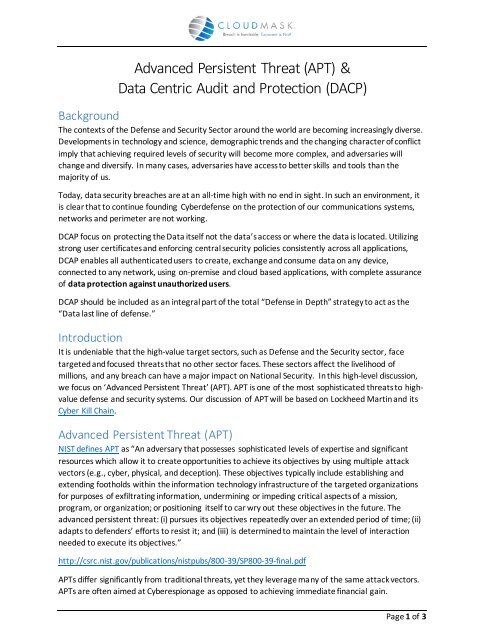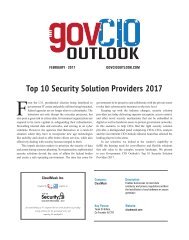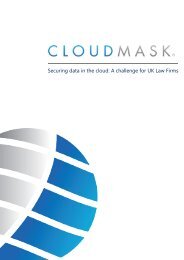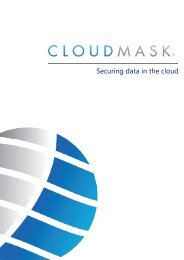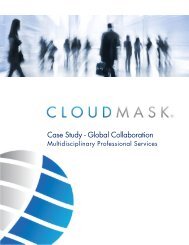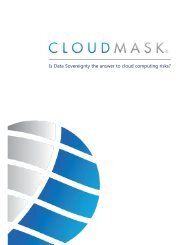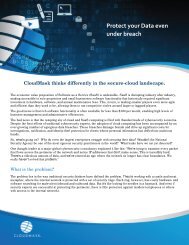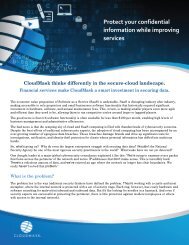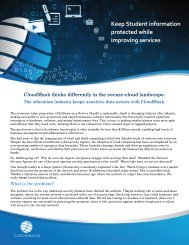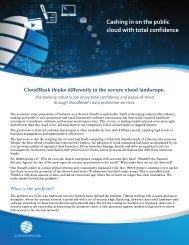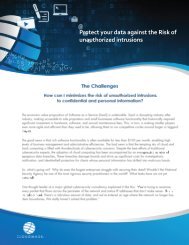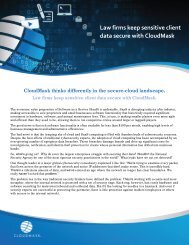Advanced Persistent Threat (APT) & Data Centric Audit and Protection (DACP)
It is undeniable that the high-value target sectors, such as Defense and the Security sector, face targeted and focused threats that no other sector faces. These sectors affect the livelihood of millions, and any breach can have a major impact on National Security. In this high-level discussion, we focus on ‘Advanced Persistent Threat’ (APT). APT is one of the most sophisticated threats to high-value defense and security systems. Our discussion of APT will be based on Lockheed Martin and its Cyber Kill Chain.
It is undeniable that the high-value target sectors, such as Defense and the Security sector, face targeted and focused threats that no other sector faces. These sectors affect the livelihood of millions, and any breach can have a major impact on National Security. In this high-level discussion, we focus on ‘Advanced Persistent Threat’ (APT). APT is one of the most sophisticated threats to high-value defense and security systems. Our discussion of APT will be based on Lockheed Martin and its Cyber Kill Chain.
Create successful ePaper yourself
Turn your PDF publications into a flip-book with our unique Google optimized e-Paper software.
<strong>Advanced</strong> <strong>Persistent</strong> <strong>Threat</strong> (<strong>APT</strong>) &<br />
<strong>Data</strong> <strong>Centric</strong> <strong>Audit</strong> <strong>and</strong> <strong>Protection</strong> (<strong>DACP</strong>)<br />
Background<br />
The contexts of the Defense <strong>and</strong> Security Sector around the world are becoming increasingly diverse.<br />
Developments in technology <strong>and</strong> science, demographic trends <strong>and</strong> the changing character of conflict<br />
imply that achieving required levels of security will become more complex, <strong>and</strong> adversaries will<br />
change <strong>and</strong> diversify. In many cases, adversaries have access to better skills <strong>and</strong> tools than the<br />
majority of us.<br />
Today, data security breaches are at an all-time high with no end in sight. In such an environment, it<br />
is clear that to continue founding Cyberdefense on the protection of our communications systems,<br />
networks <strong>and</strong> perimeter are not working.<br />
DCAP focus on protecting the <strong>Data</strong> itself not the data’s access or where the data is located. Utilizing<br />
strong user certificates <strong>and</strong> enforcing central security policies consistently across all applications,<br />
DCAP enables all authenticated users to create, exchange <strong>and</strong> consume data on any device,<br />
connected to any network, using on-premise <strong>and</strong> cloud based applications, with complete assurance<br />
of data protection against unauthorized users.<br />
DCAP should be included as an integral part of the total “Defense in Depth” strategy to act as the<br />
“<strong>Data</strong> last line of defense.”<br />
Introduction<br />
It is undeniable that the high-value target sectors, such as Defense <strong>and</strong> the Security sector, face<br />
targeted <strong>and</strong> focused threats that no other sector faces. These sectors affect the livelihood of<br />
millions, <strong>and</strong> any breach can have a major impact on National Security. In this high-level discussion,<br />
we focus on ‘<strong>Advanced</strong> <strong>Persistent</strong> <strong>Threat</strong>’ (<strong>APT</strong>). <strong>APT</strong> is one of the most sophisticated threats to highvalue<br />
defense <strong>and</strong> security systems. Our discussion of <strong>APT</strong> will be based on Lockheed Martin <strong>and</strong> its<br />
Cyber Kill Chain.<br />
<strong>Advanced</strong> <strong>Persistent</strong> <strong>Threat</strong> (<strong>APT</strong>)<br />
NIST defines <strong>APT</strong> as “An adversary that possesses sophisticated levels of expertise <strong>and</strong> significant<br />
resources which allow it to create opportunities to achieve its objectives by using multiple attack<br />
vectors (e.g., cyber, physical, <strong>and</strong> deception). These objectives typically include establishing <strong>and</strong><br />
extending footholds within the information technology infrastructure of the targeted organizations<br />
for purposes of exfiltrating information, undermining or impeding critical aspects of a mission,<br />
program, or organization; or positioning itself to car wry out these objectives in the future. The<br />
advanced persistent threat: (i) pursues its objectives repeatedly over an extended period of time; (ii)<br />
adapts to defenders’ efforts to resist it; <strong>and</strong> (iii) is determined to maintain the level of interaction<br />
needed to execute its objectives.”<br />
http://csrc.nist.gov/publications/nistpubs/800-39/SP800-39-final.pdf<br />
<strong>APT</strong>s differ significantly from traditional threats, yet they leverage many of the same attack vectors.<br />
<strong>APT</strong>s are often aimed at Cyberespionage as opposed to achieving immediate financial gain.<br />
Page 1 of 3
Stealthiness, adaptability, <strong>and</strong> persistence characterize this class of threat. For example, traditional<br />
cyber threats often try to exploit a vulnerability but will move right on to something less secure if<br />
they cannot penetrate their initial target, whereas the <strong>APT</strong> does not stop. The people <strong>and</strong> groups<br />
behind <strong>APT</strong> attacks are determined <strong>and</strong> have the resources to be able to launch zero-day attacks on<br />
enterprises. This makes it hard to defend against them.<br />
It is important to recognize that the people <strong>and</strong> groups behind <strong>APT</strong> attacks have a specific target.<br />
They are determined to penetrate target defenses <strong>and</strong> have the resources to be able to launch zeroday<br />
attacks on enterprises. This makes it hard to defend against them.<br />
Lockheed Martin Cyber Kill Chain Model<br />
“The Lockheed Martin Cyber Kill Chain® method is the core of our Intelligence Driven Defense —our<br />
differentiator in the battle against advanced persistent threats.” LM – Cyber Kill Chain<br />
1. Reconnaissance; the attacker finds a<br />
gap in security of the social network<br />
2. Weaponization; builds a<br />
malicious attachment<br />
3. Delivery; delivers the attachment<br />
using social media or email targeting<br />
an employee<br />
4. Exploitation; the employee, opens<br />
the file, <strong>and</strong> the vulnerability is<br />
exposed<br />
5. Installation; Malware immediately<br />
installs on the client<br />
6. Comm<strong>and</strong> & Control; the attacker,<br />
takes control of the system<br />
7. Actions on Objectives; pinpoint <strong>and</strong><br />
access critical data<br />
Cyber Kill Chain model reinforces<br />
perimeter-focused, malware-prevention<br />
thinking.<br />
The hard fact is, intrusion prevention<br />
solutions cannot provide 100%<br />
protection.<br />
A persistent, highly determined, <strong>and</strong><br />
highly skilled adversary will always find a way in. And once the adversary is crossed the network<br />
perimeter, traditional Cyber Kill Chain-style prevention solutions like firewalls, s<strong>and</strong>boxes, <strong>and</strong><br />
antivirus can’t help. Once they’ve bypassed these boundaries, adversaries are free to operate in the<br />
network unobstructed.<br />
Page 2 of 3
CloudMask an <strong>DACP</strong> Solution<br />
CloudMask is a <strong>DACP</strong> security platform. Using patent methods, CloudMask, running on end devices,<br />
transparently intercepts <strong>and</strong> analyzes data to identify, tokenize, <strong>and</strong> encrypt sensitive information.<br />
The intercepted data may belong to a variety of applications, such as Google, SalesForce, Box, etc.,<br />
<strong>and</strong>/or any other on-premises applications.<br />
CloudMask converts sensitive data into tokens that have the same structure as the original data but<br />
are meaningless, jumbled texts bearing no relation to the original data. As a result, the application<br />
receives meaningless tokens, instead of the original private data. These tokens do not break the<br />
application’s functionality. Accordingly, the application continues to function as before, without<br />
requiring any changes to existing applications. This allows data to be safe even in the face of <strong>APT</strong>. We<br />
assume that the attackers will breach defenses but ensure that they will not be able to find any<br />
meaningful data.<br />
These techniques also apply to on-premise applications, <strong>and</strong> accordingly CloudMask mitigates insider<br />
threats by utilizing user-owned keys (asymmetric key pair). These keys are never shared or<br />
transmitted over the network. Only users/systems explicitly authorized by the data owner may use<br />
their personal keys to restoring tokens back to their meaningful data.<br />
<strong>DACP</strong> protects critical data even when the “Kill Chain” will compromise<br />
With CloudMask’s data protection under breach, infrastructure breaches no longer mean data<br />
breaches. Insecure clouds <strong>and</strong> mobile devices no longer mean insecure enterprise data. An insider<br />
possessing application <strong>and</strong> system access no longer means seeing the data.<br />
Page 3 of 3


